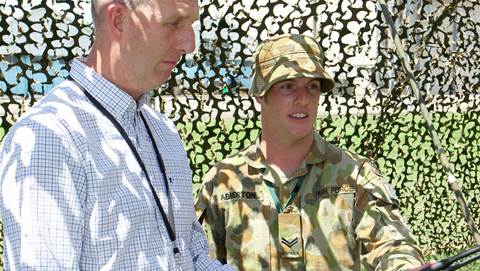Regional pay-TV company Austar has never paid top dollar for a Customer Relationship Management (CRM) system, but claims to have better data on its customers than just about any other organisation.
Nor has Austar ever ripped out and replaced its storage hardware, and yet it suffers none of the 'information glut' hampering other organisations.
Nor does it spend tens of millions on running a secondary data centre for disaster recovery, but it could still have services back up within the hour should its primary site on the Gold Coast be swept out to sea.
What Austar does have is a CIO that has been with the company close to a decade and knows how to get the best out of the IT resources he has.
This week iTnews caught up with Austar CIO Dean Walters to discuss some of the ways his 'no frills' approach to IT has saved the company millions.
The 'no frills' solution to data storage growth
In under a decade, Walters has twice upgraded the storage infrastructure at Austar, but is yet to switch off an array.
"There are two distinct approaches to managing the growth of data," Walters told iTnews. "The first is to try and limit or control the data to limit and control the costs associated with storing it.
"The second is to accept that information will always grow exponentially and to find a cost-effective solution to storing all your information - working with the business to come up with strategies to make best use of it."
Austar has taken on the latter strategy - and keeps a record of every transaction and interaction it has with customers.
"We have rules around the currency of data - quotas on mail files and auto archives to take older files into cheaper storage," he says. "But aside from that I find it difficult to justify the deletion of data."
Austar comes into contact with its customers once or twice a month, either through a billing event or change of product (subscribing to a new channel). The pay-TV company meticulously collects all the data from its IVR system, its web sites, and discussions with customers on the phone or by mail and email.
"It is all valuable information," Walters said. "Through those touch points we generate a lot of intelligence around the mood, openness and attitudes to service of our customers. Importantly, we learn about a customer's propensity to leave the service."
Austar's first storage area network, acquired some ten years ago, was 2 terabytes in size and hosted on a modular Hitachi Data Systems 9200 series array. It lasted little under a year as the company's primary storage device. The company soon upgraded to the 9500 series. In 2007, it again upgraded to HDS's NSC55 series. The company now manages some 60 terabytes of storage.
"We are looking at being able to sweat the assets rather than retire and replace them, by shifting older machines down the data lifecycle," he said.
The NSC55 arrays are being used for access to real-time OLTP (online transaction processing) systems, while the older machines are used for such applications as archived storage.
"Considering how cheap secondary storage is, I wonder why any SME would throw away any data," Walters said. "It is debatable today whether holding on to old data is a luxury or a necessity.
"If you can hold on to an array for eight years, the cost of that technology investment is well and truly paid off."
The 'no-frills' solution to CRM
Interestingly, while Austar has recorded all its interactions with customers and uses that data routinely - it has done so without any investment in an off-the-shelf CRM suite.
"We have never gone down the CRM path," Walters said. "The numbers are simply awful on the amount of project failures."
Instead, Austar meticulously records all interactions in a standard fashion, and routinely asks the business what specific business problems need to be resolved, after which the IT team searches its repository of customer data for solutions.
Walters said the company has "richer" information around service location data than any other company - drilling right down into where a customer lives and the dimensions of their roof.
The credit status of a customer is also available to systems in real-time, such that calls from customers with poor credit records can be automatically routed to the relevant representatives and requests for upgrade packages can automatically be blocked.
"A lot of this is around managing what a good customer is," Walters said. "Churn is a major cost to the business. If you can keep good customers, or not re-acquire a delinquent customer, you're ahead."
Customer data is also used to plan ahead.
"I still have data going back to a subscription management system in 2000," Walters said. "We can measure the seasonal impact of summer over the last five years, or the impact of a summer Olympics, to help us make decisions around consumer behaviour."
Austar's systems also record consumer preferences - allowing the company to make recommendations based on prior behaviour in the style of Amazon.com.
If, for example, boxer Anthony Mundine is scheduled to battle it out in the ring in the coming weeks, Austar can mail out or SMS offers for fans of boxing or other sports to pre-register to view the event.
"Consuming entertainment is such a personal experience," Walters said. "From an IT perspective it is painful for me to suddenly take 10,000 orders for viewing the next Mundine fight. Pre-registrations mean that we take some of the strain off the transactions. Today we don't take 50 percent of transactions with staff - customers can self-service to pay-per-view or to upgrade to a new package."
The IPTV revolution, which Walters expects to be just around the corner, will make these interactions even more crucial.
"As customers consume content in different ways - be it on-demand, over the web or via subscription - we are going to need to understand more about their behaviour, what they are consuming, and how they consume it," he said.
"We want to personalise not only via what customers watch through the portal but what they are browsing on the web. As customers start changing their habits, we want to align ourselves with their preferences."
Walters said all of this personalisation is possible without CRM systems.
"We've done this in a methodical, point solution approach," he said. "There are no multimillion dollar software products and no projects that run for a year or more without results."
Read on for how Walters gets business buy-in for new projects...




.png&h=140&w=231&c=1&s=0)
_(20).jpg&h=140&w=231&c=1&s=0)



_(26).jpg&w=100&c=1&s=0)

 iTnews Executive Retreat - Security Leaders Edition
iTnews Executive Retreat - Security Leaders Edition












_(1).jpg&h=140&w=231&c=1&s=0)



